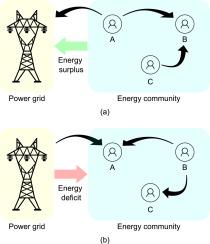Economic assessment of self-consumption and energy communities: Profit distribution insights from a real case study
IF 7.6
Q1 ENERGY & FUELS
引用次数: 0
Abstract
The deployment of solar energy for self-consumption provides an opportunity to restructure energy systems by harnessing energy and allowing individuals to actively participate in the energy transition, resulting in more significant profits. This work compares the photovoltaic (PV) electricity production for residential prosumers under three scenarios, in which: (1) the PV systems are designed to supply the individual demands of each user optimally; (2) with the exact PV capacity of the first scenario, the users decide to form an energy community; and (3), the prosumers decide to consolidate as an energy community from the beginning, and the whole PV system is designed to cover the demand of all the users optimally. Results show that energy communities in general, and creating the community from zero in particular, are more cost-effective than when the prosumers invest and manage their own PV system individually. The paper also discusses the distribution of the additional profits considering four allocation strategies, with the sharing approach based on the optimal individual photovoltaic power capacity being the most advantageous for all prosumers of the community. Specifically, with this sharing strategy, all prosumers reduce their payback, all prosumers increase the Net Present Value of their investment, and all prosumers pay less than 50% of what they pay when they do not have a self-consumption installation.

自我消费和能源社区的经济评估:来自真实案例研究的利润分配见解
自我消费的太阳能部署提供了一个通过利用能源和允许个人积极参与能源转型来重组能源系统的机会,从而产生更大的利润。本文比较了三种情况下住宅产消户的光伏发电,其中:(1)光伏系统被设计为最优地满足每个用户的个性化需求;(2)以第一种场景的确切光伏容量,用户决定组成能源社区;(3)产消者从一开始就决定整合为一个能源共同体,整个光伏系统的设计将最优地覆盖所有用户的需求。结果表明,总的来说,能源社区,特别是从零开始创建社区,比生产消费者单独投资和管理自己的光伏系统更具成本效益。本文还讨论了考虑四种分配策略的额外利润分配,其中基于最优个体光伏发电容量的共享方法对社区所有产消者最有利。具体来说,在这种共享策略下,所有的生产消费者都减少了他们的投资回报,所有的生产消费者都增加了他们投资的净现值,并且所有的生产消费者在没有自我消费装置的情况下支付的费用低于他们支付的费用的50%。
本文章由计算机程序翻译,如有差异,请以英文原文为准。
求助全文
约1分钟内获得全文
求助全文
来源期刊

Energy Conversion and Management-X
Multiple-
CiteScore
8.80
自引率
3.20%
发文量
180
审稿时长
58 days
期刊介绍:
Energy Conversion and Management: X is the open access extension of the reputable journal Energy Conversion and Management, serving as a platform for interdisciplinary research on a wide array of critical energy subjects. The journal is dedicated to publishing original contributions and in-depth technical review articles that present groundbreaking research on topics spanning energy generation, utilization, conversion, storage, transmission, conservation, management, and sustainability.
The scope of Energy Conversion and Management: X encompasses various forms of energy, including mechanical, thermal, nuclear, chemical, electromagnetic, magnetic, and electric energy. It addresses all known energy resources, highlighting both conventional sources like fossil fuels and nuclear power, as well as renewable resources such as solar, biomass, hydro, wind, geothermal, and ocean energy.
 求助内容:
求助内容: 应助结果提醒方式:
应助结果提醒方式:


